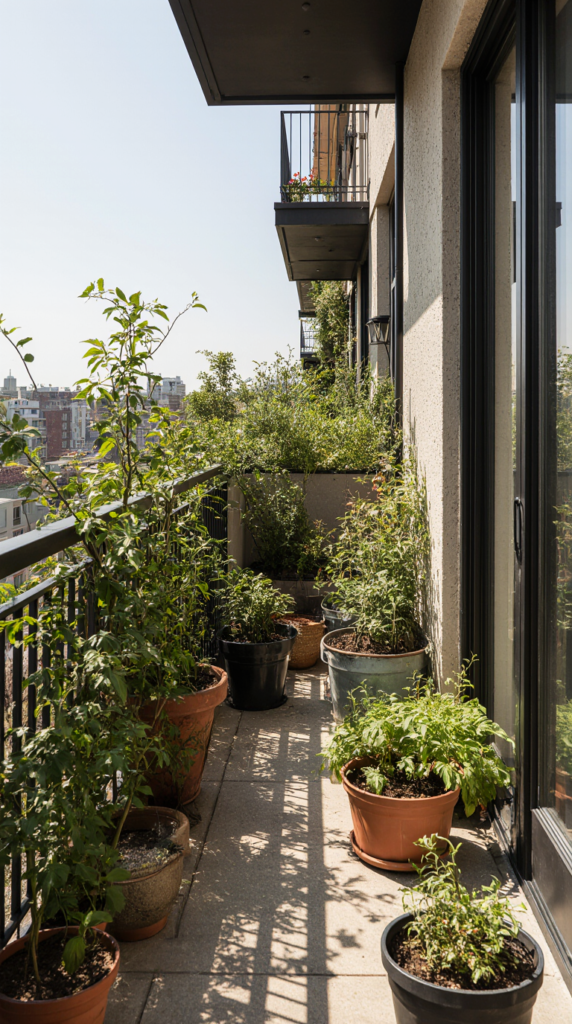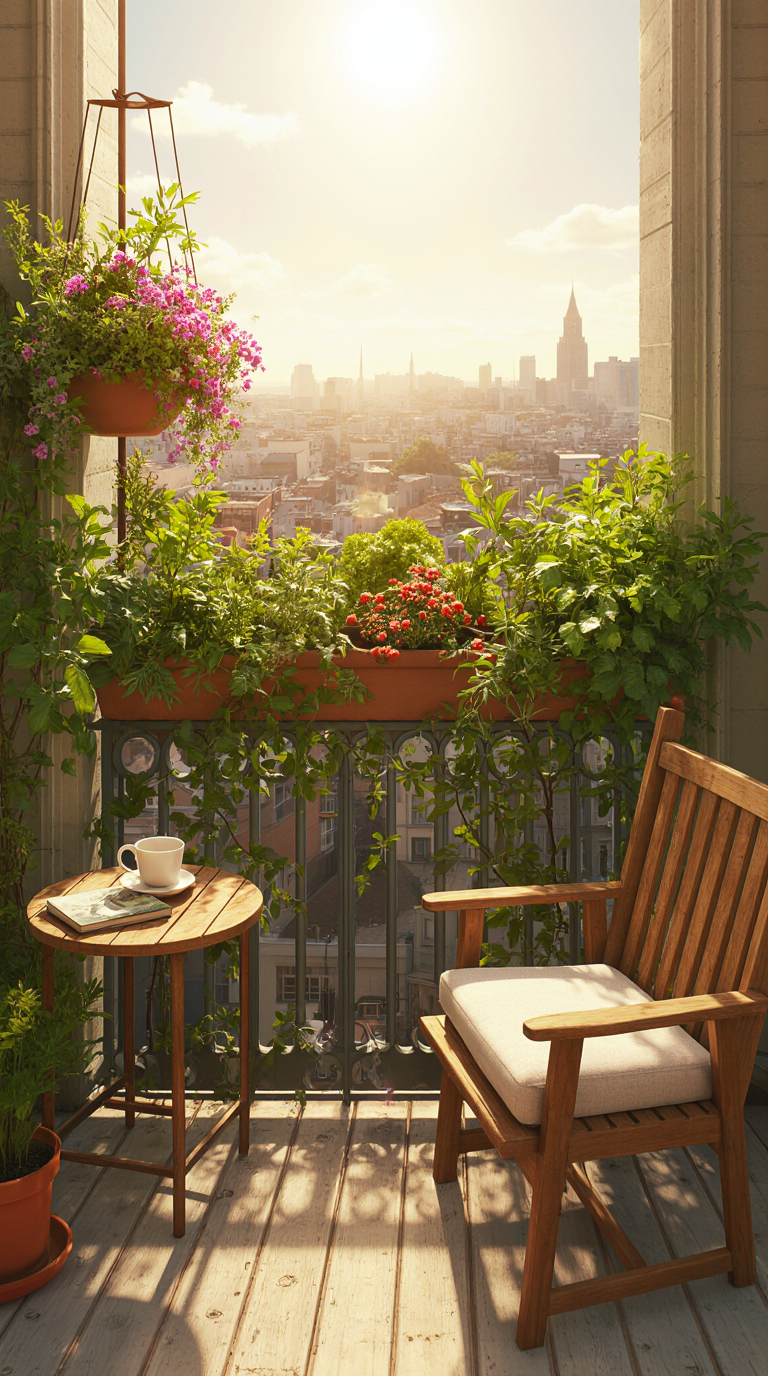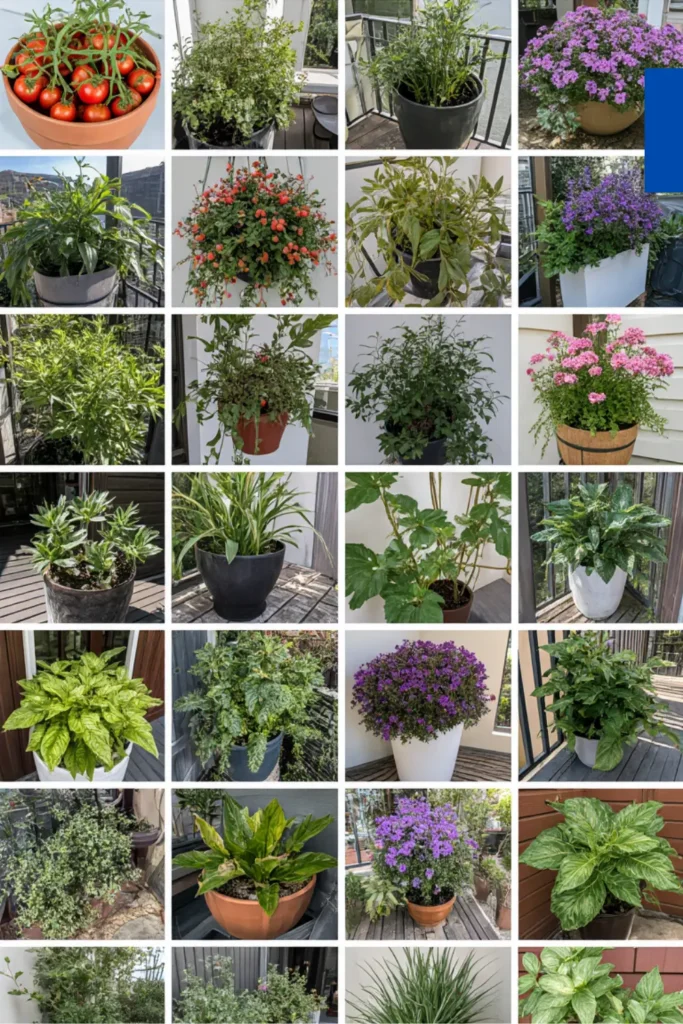Transforming Your Balcony into a Living Paradise
There’s something deeply satisfying about stepping onto your balcony and being greeted by flourishing plants, vibrant flowers, and perhaps even your own homegrown herbs and vegetables. I still remember the day I transformed my drab, concrete balcony into a lush sanctuary—how the simple act of nurturing those first seedlings connected me to nature despite living eight floors up in a bustling city.
Balcony gardening isn’t just about beautifying a small outdoor space; it’s about creating your personal retreat, improving air quality, and even supplementing your kitchen with fresh produce. Whether you have a tiny apartment balcony or a more spacious terrace, this guide will help you transform that neglected space into a thriving green oasis.
The beauty of balcony gardening lies in its accessibility—you don’t need acres of land or years of experience to create something beautiful. With thoughtful planning, the right plants, and a touch of creativity, even complete beginners can succeed. Let’s explore how to build your own balcony garden, from understanding your space to selecting the perfect plants for your conditions.
Table of Contents
Understanding Your Balcony’s Environment
Assessing Light Conditions
Before purchasing a single plant, take time to observe your balcony’s light patterns throughout the day. Light conditions are perhaps the most crucial factor in determining which plants will thrive in your space.
Types of light exposure your balcony might receive:
- Full sun: 6+ hours of direct sunlight daily
- Partial sun/partial shade: 3-6 hours of direct sunlight
- Dappled shade: Light filtered through trees or structures
- Full shade: Less than 3 hours of direct sunlight
Track sunlight on your balcony for a week, noting which areas receive direct light and for how long. Remember that light conditions change seasonally—a balcony that’s shaded in winter might receive full sun in summer as the sun’s position shifts.
Wind Exposure and Microclimate
High-rise balconies often experience stronger winds than ground-level gardens. Understanding your balcony’s wind patterns helps you:
- Select wind-resistant plants
- Create windbreaks where necessary
- Determine appropriate container weights to prevent tipping
Temperature is another consideration—balconies can be significantly warmer or cooler than the surrounding area depending on their orientation, building materials, and protection from elements. Urban balconies may benefit from the “heat island effect,” potentially extending your growing season.
Weight and Space Limitations
Before enthusiastically filling your balcony with potted plants, consider these practical constraints:
| Consideration | What to Check | Why It Matters |
|---|---|---|
| Weight Limits | Building regulations, lease agreements | Soil, containers, and water add significant weight |
| Usable Space | Floor dimensions, vertical options | Determines container quantity and arrangement |
| Privacy Needs | Visibility from neighboring units | May influence plant selection and placement |
| Water Access | Distance to nearest water source | Affects watering routine and potential irrigation solutions |
Remember that wet soil weighs significantly more than dry soil—a medium-sized container can easily weigh 20-30 pounds when saturated. If weight restrictions are a concern, consider lightweight containers and soil mixes specifically designed for container gardening.
Essential Supplies for Your Balcony Garden
Selecting the Right Containers
Containers are the foundation of your balcony garden, and choosing wisely affects both aesthetics and plant health:
Container Options for Balcony Gardens:
- Terracotta pots: Classic look, porous material allows soil to breathe but dries out quickly
- Plastic containers: Lightweight, affordable, good water retention
- Ceramic planters: Decorative, less porous than terracotta, often heavier
- Fabric pots: Extremely lightweight, promotes root health through air pruning
- Railing planters: Space-saving option that hangs on balcony railings
- Vertical planters: Maximize growing space by utilizing wall space
- Upcycled containers: Repurposed items like wooden crates, buckets, or even old sinks
Regardless of material, ensure all containers have adequate drainage holes. Without proper drainage, roots can rot, leading to plant death.
Soil and Amendments
Unlike ground gardens, container plants depend entirely on the soil you provide. Regular garden soil is too dense for containers and can become compacted over time.
Instead, use high-quality potting mix specifically formulated for containers. These mixes typically contain:
- Peat moss or coco coir for water retention
- Perlite or vermiculite for aeration
- Compost for nutrients
- Sometimes slow-release fertilizer
For vegetables or herbs, consider specialized vegetable potting mixes. These typically contain higher proportions of organic matter to support productive plants.
Tools and Accessories
You don’t need an extensive tool collection for balcony gardening, but a few basics will make maintenance easier:
- Hand trowel for planting and repotting
- Pruning shears for harvesting and maintenance
- Watering can or hose attachment suitable for your space
- Small hand rake for soil aeration
- Spray bottle for misting and foliar feeding
- Plant supports (stakes, cages, trellises) for climbing plants
- Gloves to protect your hands
Storage can be challenging on a balcony. Consider a small weather-resistant deck box or wall-mounted tool organizer to keep supplies tidy and accessible.
Choosing Plants for Your Balcony Garden
Best Plants for Sunny Balconies
If your balcony receives 6+ hours of direct sunlight daily, you have numerous exciting options:
Edibles for Sunny Balconies:
- Tomatoes (cherry varieties are particularly container-friendly)
- Peppers (both sweet and hot varieties)
- Eggplants
- Herbs like basil, rosemary, thyme, and sage
- Strawberries
- Bush beans
Ornamentals for Sunny Balconies:
- Petunias
- Geraniums
- Lavender
- Sunflowers (dwarf varieties)
- Marigolds
- Zinnias
- Succulents and cacti
Shade-Tolerant Options
Limited sunlight doesn’t mean limited options. These plants thrive in partial to full shade:
Edibles for Shaded Balconies:
- Leafy greens (lettuce, spinach, kale, arugula)
- Mint and other shade-tolerant herbs
- Chives
- Asian greens like bok choy
Ornamentals for Shaded Balconies:
- Begonias
- Impatiens
- Ferns
- Coleus
- Caladiums
- Peace lilies
- Snake plants
Space-Efficient Varieties
When space is at a premium, these compact or vertical-growing plants maximize your growing area:
Compact vegetables:
- Determinate tomato varieties
- Bush cucumbers
- Mini bell peppers
- Dwarf eggplants
Climbers and vines (with appropriate supports):
- Pole beans
- Peas
- Cucumbers
- Morning glories
- Nasturtiums
Cascading plants for hanging baskets:
- Trailing petunias
- Lobelia
- String of pearls
- Strawberries (in hanging strawberry planters)
Year-Round Interest
For continuous visual interest, plan for succession planting and include plants with different blooming periods:
- Spring: Pansies, tulips, daffodils
- Summer: Petunias, geraniums, verbena, vegetables
- Fall: Chrysanthemums, ornamental kale, pansies
- Winter: Evergreen shrubs, winter pansies, ornamental grasses
In colder climates, consider bringing tender perennials indoors during winter or focusing on cold-hardy plants that can withstand freezing temperatures.
Setting Up Your Balcony Garden
Efficient Layout Planning
Before placing a single container, sketch your balcony layout considering:
- Traffic flow (ensure you can still comfortably move around)
- Varying heights (taller plants at the back/sides, shorter in front)
- Visual interest from both inside and outside
- Access for maintenance and harvesting
- Weight distribution (place heavier containers near supporting walls)
Group plants with similar water and light needs together to simplify care. This practice, known as “zoning,” makes maintenance more efficient and improves plant health.
Irrigation Solutions
Consistent watering is essential for container plants, which dry out faster than in-ground gardens. Consider these options:
Manual Watering Systems:
- Watering can (best for small balconies or few plants)
- Hose with attachment (if you have an outdoor water source)
- Indoor faucet adapters (connect a hose to kitchen or bathroom faucets)
Automatic Watering Solutions:
- Self-watering containers (built-in water reservoirs)
- Drip irrigation systems (set on timers for consistent moisture)
- Wicking systems (utilize capillary action to draw water up from a reservoir)
- Moisture meters (help determine when plants truly need water)
Morning watering is generally best, allowing foliage time to dry before evening to reduce disease risk.

Vertical Gardening Techniques
When floor space is limited, growing upward maximizes your gardening potential:
Vertical Solutions for Balconies:
Wall-mounted systems:
- Pocket planters
- Modular wall systems
- Repurposed pallets
Freestanding options:
- Plant stands with multiple tiers
- Tower gardens
- Trellises and plant supports
Hanging solutions:
- Ceiling hooks for hanging baskets
- Tension rods between walls for hanging plants
- Railing-mounted flower boxes
Maintaining Your Balcony Garden
Seasonal Care Calendar
Regular maintenance keeps your balcony garden thriving throughout the year:
Spring Tasks:
- Clean containers and balcony space
- Prepare and refresh potting soil
- Start seeds or purchase seedlings
- Prune perennials from previous season
- Begin fertilization schedule
Summer Tasks:
- Increase watering frequency during hot periods
- Monitor for pests and diseases
- Deadhead flowering plants to encourage continuous blooming
- Harvest vegetables and herbs regularly
- Provide shade for sensitive plants during extreme heat
Fall Tasks:
- Replace summer annuals with fall varieties
- Reduce fertilization as growth slows
- Prepare tender perennials for winter
- Harvest final vegetables before frost
- Clean and store unused containers
Winter Tasks:
- Protect containers from freezing (insulate or move indoors)
- Water sparingly as growth slows
- Monitor overwintering plants for pests
- Plan next season’s garden
- Order seeds for early spring starting
Fertilizing Container Plants
Container plants require more frequent fertilization than in-ground plants since nutrients leach out with watering:
Fertilizer Options for Balcony Gardens:
| Fertilizer Type | Application | Best For |
|---|---|---|
| Slow-release granules | Apply once every 2-3 months | Low-maintenance gardening |
| Liquid fertilizers | Apply every 2-4 weeks | Fast-growing vegetables |
| Compost tea | Apply biweekly | Organic gardening approach |
| Fish emulsion | Apply monthly | Both ornamentals and edibles |
Follow package directions carefully—over-fertilizing can damage plants and contribute to environmental pollution when excess nutrients wash off your balcony.
Pest Management in Urban Settings
Even high-rise balconies can experience pest problems. Manage them with these strategies:
Prevention:
- Inspect new plants before bringing them home
- Maintain appropriate spacing between plants
- Keep foliage dry when watering
- Remove dead or diseased plant material promptly
Identification:
- Common balcony pests include aphids, spider mites, whiteflies, and fungus gnats
- Yellow sticky cards help monitor flying insect populations
- Regular inspection of leaf undersides catches problems early
Treatment:
- Start with least toxic options like water spray or hand-removal
- Consider insecticidal soaps or neem oil for persistent problems
- Biological controls like beneficial insects work well in contained environments
Remember that balcony gardens exist in close proximity to living spaces—prioritize safe pest management approaches that won’t compromise your health or that of your neighbors.
Creative Balcony Garden Ideas
Theme Gardens for Small Spaces
Even with limited space, you can create a themed garden that reflects your interests:
Culinary herb garden:
- Mediterranean herbs like rosemary, thyme, oregano, and basil
- Asian herbs like Thai basil, lemongrass, and cilantro
- Tea garden with mint varieties, chamomile, and lemon balm
Pollinator paradise:
- Nectar-rich flowers like zinnias, cosmos, and salvias
- Native flowering plants appropriate for your region
- Shallow water dish for butterfly and bee hydration
Ornamental edibles garden:
- Rainbow chard with colorful stems
- Purple basil and variegated sage
- Nasturtiums with edible flowers
- Ornamental peppers with colorful fruits
Sensory garden:
- Fragrant plants like lavender, jasmine, and scented geraniums
- Textural plants like lamb’s ear and ornamental grasses
- Plants with sound elements like bamboo that rustles in the breeze
Sustainable Balcony Gardening Practices
Incorporate these eco-friendly approaches:
- Collect rainwater in small barrels or containers
- Compost kitchen scraps in a compact, odor-free compost bin designed for apartments
- Choose organic fertilizers and pest control methods
- Reuse household items as containers
- Select native plants adapted to your local climate
- Install solar-powered lights for evening enjoyment
Combining Form and Function
Your balcony garden can be both beautiful and productive:
- Arrange containers with consideration for color, texture, and height
- Incorporate decorative elements like small sculptures or weather-resistant art
- Use attractive trellises that serve as both plant supports and visual dividers
- Install outdoor-friendly fabric for shade that adds color and pattern
- Consider furniture that doubles as planting space, like benches with built-in planters
Conclusion: Your Personal Green Retreat
Creating a balcony garden is more than just arranging plants in containers—it’s about cultivating a personal sanctuary that connects you to nature despite urban living constraints. Start small with a few well-chosen plants, learn from both successes and failures, and gradually expand as your confidence grows.
Remember that balcony gardening is an evolving practice. Your garden will change with the seasons, your growing expertise, and your personal preferences. Embrace this evolution as part of the joy of gardening.
The rewards extend beyond beautiful blooms or fresh herbs—there’s profound satisfaction in nurturing life in a concrete environment, in creating habitat for beneficial insects, and in bringing a touch of nature’s rhythm into daily urban life. Your balcony garden becomes a living expression of care—for plants, for the environment, and ultimately, for yourself.
For more gardening tips follow us on Pinterest
FAQs About Balcony Gardening
What plants are good for balcony gardens?
Great balcony plants include herbs (basil, mint, parsley), flowering plants (petunias, geraniums, marigolds), and compact vegetables (cherry tomatoes, lettuce, peppers). Choose plants based on your balcony’s sunlight and space.
What is the easiest vegetable to grow on a balcony?
Lettuce is one of the easiest vegetables to grow in containers—it grows quickly, doesn’t need deep soil, and thrives in partial sunlight. Other beginner-friendly options include radishes, green onions, and spinach.
What plants can you put on a balcony with no direct sunlight?
In low-light balconies, go for shade-tolerant plants like ferns, snake plants, pothos, peace lilies, and herbs like mint or parsley. These plants thrive without needing full sun.
What to buy for a balcony garden?
Essentials include:
Containers or pots with drainage holes
Potting soil (not regular garden soil)
Seeds or starter plants
Watering can or hose attachment
Fertilizer (organic is great for edibles)
Optional: self-watering planters, trellises, plant stands, or drip irrigation for ease
How often should I water my balcony garden?
Most balcony garden plants need watering when the top inch of soil feels dry. During hot summer months, this might mean daily watering, while in cooler seasons, once or twice weekly may suffice. Container plants generally need more frequent watering than in-ground gardens.
What’s the best soil to use for balcony gardening?
Use high-quality potting mix specifically formulated for containers, not garden soil which can compact and drain poorly. For vegetables, choose potting mixes designed for edibles. Consider adding water-retaining polymers in hot climates to reduce watering frequency.
Can I grow vegetables on a north-facing balcony with limited sunlight?
Yes, though your options are more limited. Focus on leafy greens like lettuce, spinach, kale, and herbs such as mint and parsley, which can thrive with 3-4 hours of indirect light. Root vegetables and fruiting plants generally won’t produce well without more direct sunlight.
What are the best balcony gardening containers for beginners?
Self-watering containers are ideal for beginners as they provide consistent moisture. Plastic pots are lightweight, affordable, and retain moisture well. Start with containers at least 10-12 inches deep for most plants, and ensure they have drainage holes.
How do I protect my balcony garden from strong winds?
Install transparent wind breaks or privacy screens, position larger plants at the perimeter as windbreaks, use heavier containers that won’t tip easily, and consider securing tall plants with stakes. During extreme wind events, temporarily move vulnerable plants to protected area

